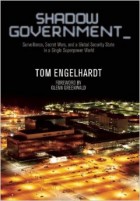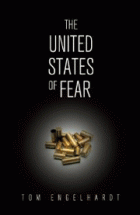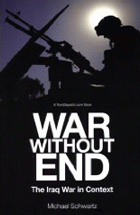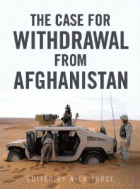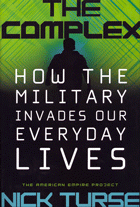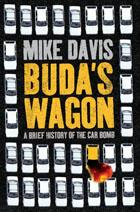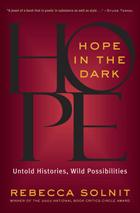[Note for TomDispatch Readers: Alfred McCoy’s new Dispatch Book, In the Shadows of the American Century: The Rise and Decline of U.S. Global Power, won’t officially be published until September, but it's already getting extraordinary attention. That would include Jeremy Scahill’s powerful podcast interview with McCoy at the Intercept, a set of striking prepublication notices (Kirkus Reviews: "Sobering reading for geopolitics mavens and Risk aficionados alike"), and an impressive range of blurbs (Andrew Bacevich: “This is history with profound relevance to events that are unfolding before our eyes”; Ann Jones: “eye-opening... America’s neglected citizens would do well to read this book”; Oliver Stone: “One of our best and most underappreciated historians takes a hard look at the truth of our empire, both its covert activities and the reasons for its impending decline”). Of him, Scahill has said, “Al McCoy has guts... He helped put me on the path to investigative journalism.” In today’s post, adapted by McCoy from the introduction to In the Shadows of the American Century, you’ll get a taste of just what Scahill means. So read it and then pre-order a copy of the latest book from the man who battled the CIA and won.
With today’s post, I'm closing TomDispatch through Labor Day. We’ll be back on September 5th. Tom]
When historian Alfred McCoy began his long journey to expose some of the darkest secrets of the U.S. national security establishment, America was embroiled in wars in Vietnam, Laos, and Cambodia. Almost 50 years later, the United States is, in one way or another, involved in so many more conflicts from Afghanistan, Iraq, Syria, and Yemen to Libya, Somalia, the Lake Chad region of Africa, and the Philippines.
To understand how the U.S. went from three interventions that actually ended to a proliferating collection of quasi-wars seemingly without end would require a detailed map to guide you through some of the thorniest wilds of American foreign policy. Luckily, McCoy is still on the case with his buzz-generating blockbuster-to-be: In the Shadows of the American Century: The Rise and Decline of U.S. Global Power.
He first stumbled upon some of the secrets of the national security state when, in the early 1970s, he started down Southeast Asia’s “heroin trail” and into a shadow world of black ops, mercenaries, and drug lords. It’s a tale fit for a John le Carré novel or, better yet, a seedy bar where the air is hot and still, the customers are rough, and the drinks strong. If TomDispatch regular McCoy told you his story over a whiskey, you’d be obliged to buy the next round. It’s that kind of tale. Today, however, you’re in luck and he shares it with you for free. Nick Turse
Exploring the Shadows of America’s Security State
Or How I Learned Not to Love Big Brother
By Alfred W. McCoy[This piece has been adapted and expanded from the introduction to Alfred W. McCoy’s new book, In the Shadows of the American Century: The Rise and Decline of U.S. Global Power.]
In the wake of the 2001 terrorist attacks, Washington pursued its elusive enemies across the landscapes of Asia and Africa, thanks in part to a massive expansion of its intelligence infrastructure, particularly of the emerging technologies for digital surveillance, agile drones, and biometric identification. In 2010, almost a decade into this secret war with its voracious appetite for information, the Washington Post reported that the national security state had swelled into a “fourth branch” of the federal government -- with 854,000 vetted officials, 263 security organizations, and over 3,000 intelligence units, issuing 50,000 special reports every year.
Though stunning, these statistics only skimmed the visible surface of what had become history’s largest and most lethal clandestine apparatus. According to classified documents that Edward Snowden leaked in 2013, the nation’s 16 intelligence agencies alone had 107,035 employees and a combined “black budget” of $52.6 billion, the equivalent of 10% percent of the vast defense budget.
By sweeping the skies and probing the worldwide web’s undersea cables, the National Security Agency (NSA) could surgically penetrate the confidential communications of just about any leader on the planet, while simultaneously sweeping up billions of ordinary messages. For its classified missions, the CIA had access to the Pentagon’s Special Operations Command, with 69,000 elite troops (Rangers, SEALs, Air Commandos) and their agile arsenal. In addition to this formidable paramilitary capacity, the CIA operated 30 Predator and Reaper drones responsible for more than 3,000 deaths in Pakistan and Yemen.
While Americans practiced a collective form of duck and cover as the Department of Homeland Security’s colored alerts pulsed nervously from yellow to red, few paused to ask the hard question: Was all this security really directed solely at enemies beyond our borders? After half a century of domestic security abuses -- from the “red scare” of the 1920s through the FBI’s illegal harassment of antiwar protesters in the 1960s and 1970s -- could we really be confident that there wasn’t a hidden cost to all these secret measures right here at home? Maybe, just maybe, all this security wasn’t really so benign when it came to us.
From my own personal experience over the past half-century, and my family’s history over three generations, I’ve found out in the most personal way possible that there’s a real cost to entrusting our civil liberties to the discretion of secret agencies. Let me share just a few of my own “war” stories to explain how I’ve been forced to keep learning and relearning this uncomfortable lesson the hard way.
[Note for TomDispatch Readers: As I suggest in my introduction, this is an increasingly dystopian moment in America, which makes it the perfect moment to remind TD readers that, for a contribution of $100 or more ($125 if you live outside the United States), you can get a signed, personalized copy of John Feffer’s riveting dystopian novel, Splinterlands. (Check out our donation page for the details.) And for just a few bucks, you can get an unsigned but no less riveting copy of that book, which Barbara Ehrenreich -- in a comment that has only become more apt by the week -- called “a startling portrait of a post-apocalyptic tomorrow that is fast becoming a reality today.” Tom]
If you happen to be a dystopian novelist, as TomDispatch regular John Feffer is, then you’re in business these days. Back in 2015, when Donald Trump's campaign for the presidency was just heating up and Feffer was writing Splinterlands, his vivid look back from the year 2050 at our shattered planet, he named the massive storm that would devastate Washington in 2022 “Hurricane Donald” -- and you can’t be more predictively on the mark or dystopian than that. Now, in August 2017, armed bands of neo-Nazis and white supremacists are in our streets and we have a president whose deepest desire seems to be to support them (because they support him). Meanwhile, the generals from our losing wars are manning the ramparts of an embattled administration (and being treated by the mainstream media as the “adults in the room”) and an unpredictable man-child is in the White House. In other words, the material is clearly going to be there for Feffer -- in his ordinary life a thoughtful columnist at Foreign Policy in Focus -- to devote the rest of his time to dystopian fiction.
And that’s without even mentioning America’s dystopian Asian wars of the past, present, and possibly future. They undoubtedly deserve their own grim set of novels, starting with the bloody and brutal American conquest of the Philippines. Included would also have to be the Pacific War against Japan that ended when a new weapon of unimaginable power obliterated two Japanese cities and significant parts of their populations, leaving humanity to face the possibility of its own future obliteration (and you can’t get more dystopian than that); the Vietnam War that left millions of Vietnamese, Laotians, and Cambodians (and 58,000 Americans) dead; a quarter century of Afghan Wars (the second of them now the longest in American history); and last but hardly least, the Korean War, which began in June 1950 and halted in 1953, after millions of Koreans (and 36,000 Americans) had died. By the estimate of the then-head of the U.S. Strategic Air Command, 20% of the North’s population died in those years under a rain of 635,000 tons of bombs and 32,557 tons of napalm (more than was used against the Japanese in World War II), while the North was burned to a crisp without atomic weapons.
In a strange sense, that conflict became America’s first permanent war since no peace treaty was ever agreed to -- though all American wars now seem to be permanent. Of course, with Donald Trump’s recent impromptu comment that North Korean threats “will be met with fire, fury, and frankly power the likes of which this world has never seen before,” an obvious nuclear reference made on the eve of the 72nd anniversary of the atomic bombing of Nagasaki, a future Korean inferno is once again on many minds here and elsewhere, John Feffer’s included. And yet he suggests that, if only American officialdom could rid itself of its own dystopian turn of mind when it comes to North Korea, there might be a perfectly peaceable and reasonable way forward. If only indeed... Tom
Trump and the Geopolitics of Crazy
The Times They Are A-Changin’ in North Korea
By John FefferThe United States has beaten its head against the wall of North Korea for more than 70 years, and that wall has changed little indeed as a result. The United States, meanwhile, has suffered one headache after another.
Over the last several weeks, the head banging has intensified. North Korea has tested a couple of possible intercontinental ballistic missiles. In response, Donald Trump has threatened that country with “fire and fury,” one-upping the rhetoric coming out of Pyongyang. And North Korean leader Kim Jong-un is debating whether to fire a missile or two into the waters around the American island of Guam as a warning of what his country is capable of doing.
Ignore, for the moment, Trump’s off-the-cuff belligerence. Despite all their promises to overhaul North Korea policy, his top officials have closely followed the same headache-inducing pattern as their predecessors.
[Note to TomDispatch Readers: The next TD post will appear on Tuesday, August 22nd.]
Pardon Me!
High Crimes and Demeanors in the Age of Trump
By Tom Engelhardt
Let me try to get this straight: from the moment the Soviet Union imploded in 1991 until recently just about every politician and mainstream pundit in America assured us that we were the planet’s indispensable nation, the only truly exceptional one on this small orb of ours.
We were the sole superpower, Earth’s hyperpower, its designated global sheriff, the architect of our planetary future. After five centuries of great power rivalries, in the wake of a two-superpower world that, amid the threat of nuclear annihilation, seemed to last forever and a day (even if it didn’t quite make it 50 years), the United States was the ultimate survivor, the victor of victors, the last of the last. It stood triumphantly at the end of history. In a lottery that had lasted since Europe's wooden ships first broke out of a periphery of Eurasia and began to colonize much of the planet, the United States was the chosen one, the country that would leave every imperial world-maker from the Romans to the British in its shadow.
Who could doubt that this was now our world in a coming American century beyond compare?
And then, of course, came the attacks of 9/11. A mere $400,000 and 19 suicidal hijackers (mostly Saudis) armed with box cutters and organized from Afghanistan, a country plunged into an Islamic version of the Middle Ages, had challenged the greatest power of all time. In the process, they would bring down iconic structures in what would soon be known to Americans as “the homeland,” while killing almost 3,000 innocent civilians, acts so shocking that they really did change the world.
Yet even then, a fervor for world-organizing triumphalism only took firmer hold in Washington. The top officials of President George W. Bush’s administration almost instantly saw the 9/11 attacks as their very own “Pearl Harbor,” the twenty-first-century equivalent of the moment that had launched the U.S. on the path to post-World War II superpowerdom. As Secretary of Defense Donald Rumsfeld instantly told his aides in the rubble of the Pentagon, “Go massive. Sweep it all up. Things related and not." And indeed they would do just that, seizing the moment with alacrity and promptly launching the “Global War on Terror” -- aka, among the cognoscenti, World War IV (the third, in their minds, having been the Cold War).
No simple “police action” against the modest al-Qaeda organization and Osama bin Laden would do (and those who suggested something so pathetically humble were to be laughed out of the room). At that moment, their newly launched “war” was to be aimed at no less than 60 countries. The world was to be swept clean of “terror” and the tool for doing so and for imposing Washington’s version of a world order on much of the planet would be the U.S. military, a force like none ever seen before. It was, President Bush would claim, “the greatest force for human liberation the world has ever known.” It was, as both he and Barack Obama affirmed, as became gospel on both sides of the aisle in Washington (until Donald Trump arrived in the presidential race of 2016), “the finest fighting force” in history. It was so unquestionably powerful that no enemy could conceivably stand in its path. It would “liberate” not just Afghanistan, but Iraq, a country in the Middle Eastern oil heartlands that had nothing to do with either al-Qaeda or Islamic terror but had a ruler despised in Washington.
And that, mind you, would only be the beginning. Syria and Iran would undoubtedly follow and soon enough the Greater Middle East would be brought under the aegis of a Pax Americana. Meanwhile, globally, no country or even bloc of countries would be capable of rising to challenge the United States into the imaginable future. As Bush put it in a speech at West Point in 2002, “America has, and intends to keep, military strengths beyond challenge, thereby making the destabilizing arms races of other eras pointless, and limiting rivalries to trade and other pursuits of peace.” In that year, the U.S. National Security Strategy similarly called for the country to "build and maintain" its military power “beyond challenge.”
What a soaring dream it all was! In response to the destruction of part of the Pentagon and those towers in New York City, a small group of top officials in Washington, long waiting for just such an opportunity, were determined to impose their version of order and democracy, military-first, on significant parts of the planet and no one would be capable of resisting. Not for long anyway.
Ever since 2001, when President George W. Bush launched an endless “global war” not on al-Qaeda but on a phenomenon, or perhaps simply a feeling (“terror”) and those who could potentially induce it, America’s all-too-real conflicts have become, as TomDispatch regular Rebecca Gordon writes today, ever more metaphorical. In a sense, they have come to seem so distant from our shores and lives (unless you happen to be a member of the country’s all-volunteer military or a family member of such a volunteer) as to be little short of fantastical -- or nonexistent. Who here even notices when, as in recent weeks, American military personnel again hit the ground in Yemen, or the Pentagon considers loosing its drones on jihadists in the Philippines, or U.S. raids occur in Somalia, or civilians in significant numbers continue to die in a Syrian city under American air strikes? The answer is essentially no one.
Washington’s conflicts in those distant lands couldn’t be more real and yet here in the United States they have largely been replaced by a single fantasy bogeyman: Islamic terrorism. It matters little that the actual danger to Americans at the hands of such terrorists is vanishingly small. Fear of them (and the need to feel “safe” from them) has filled American screens and minds for years, helping fund our national security state at levels that might once have staggered the imagination and prepared the way for the election of a truly strange, even fantastical president.
Think of it this way: as Washington has engaged in a set of disastrous spreading conflicts across the Greater Middle East, the population of this country has been gripped by the strangest of war fevers -- a demobilizing set of militarized fantasies largely focused on our own potential destruction that have distorted how we look at our world in dangerous and crippling ways. Rebecca Gordon, who has been writing about America’s “forever wars” and the fantasies that accompany them for some time now, considers what happens when war and metaphor become one, when militarized fantasies invade and occupy everyday life. Tom
When All the World’s a War...
And All the Men and Women Merely Soldiers
By Rebecca GordonSince September 11, 2001, the United States has been fighting a “war on terror.” Real soldiers have been deployed to distant lands; real cluster bombs and white phosphorus have been used; real cruise missiles have been launched; the first MOAB, the largest non-nuclear bomb in the U.S. arsenal, has been dropped; and real cities have been reduced to rubble. In revenge for the deaths of 2,977 civilians that day, real people -- in the millions -- have died and millions more have become refugees. But is the war on terror actually a war at all -- or is it only a metaphor?
In a real war, nations or organized non-state actors square off against each other. A metaphorical war is like a real war -- after all, that’s what a metaphor is, a way of saying that one thing is like something else -- but the enemy isn’t a country or even a single group of Islamic jihadists. It’s some other kind of threat: a disease, a social problem, or in the case of the war on terror, an emotion.
[Note for TomDispatch Readers: As we head into a steamy mid-August, TD is taking the weekend off. Next piece: Tuesday, August 15th. Tom]
You may have sensed it for a while. A significant group of American voters certainly did, since they elected a declinist president in 2016. Still, here’s the news of the month: the Pentagon has finally acknowledged it, too, as the title of a report from the U.S. Army War College’s Strategic Studies Institute makes clear: At Our Own Peril: DoD Risk Assessment in a Post-Primacy World. The “study team” at that institute which focused on global risk and the U.S. military doesn’t actually use the phrase “American decline,” but their stand-in, a “post-primacy world,” will do. They offer a vision of a planet where the unique power of the United States, that once-upon-a-time “lone superpower,” that architect of the post-Cold-War global order, is slipping fast.
And believe me, if you listen to those researchers, the future couldn’t be more perilous. Unfortunately, to grasp their assessment of the global situation, you have to run a gauntlet of daunting Pentagonese (in effect, a pidgin version of English). Still, from the weaponization of planetary “hyper-connectivity” to the rejectionism of jihadists to the maneuvering of would-be great and not-so-great powers -- you know the lineup: Russia, China, Iran, North Korea -- it’s a landscape of increasing “risk” that they believe the U.S. high command should wrap its head around fast.
You might not imagine that there could be dark humor in such a grim subject, but in that you would be wrong. The study team’s recommendations are so unexpectedly expectable -- from a military that’s carried out the disastrous war on terror -- that they should bring a sardonic smile of recognition to anyone’s face. I'm sure you won’t be surprised to learn that the study’s authors don’t expect that never-ending war to end anytime soon. In fact, they refer to this moment and the years to come ominously as the era of “Persistent Conflict 2.0.” And yet, to confront such a world, they firmly believe that what’s needed is... well, more. You know, just what the U.S. military and the national security state have been demanding from America’s politicians since 9/11 (and what Donald Trump has sworn to deliver): more of everything. More funding, more surveillance capabilities, and an expanded, upgraded military ready to take advantage of every new risk on the block, a force that must self-evidently be granted “maximum freedom of action” or what’s the point of giving it more of everything?
Here’s the crucial paragraph in their study:
“While as a rule, U.S. leaders of both political parties have consistently committed to the maintenance of U.S. military superiority over all potential state rivals, the post-primacy reality demands a wider and more flexible military force that can generate advantage and options across the broadest possible range of military demands. To U.S. political leadership, maintenance of military advantage preserves maximum freedom of action... Finally, it allows U.S. decision-makers the opportunity to dictate or hold significant sway over outcomes in international disputes in the shadow of significant U.S. military capability and the implied promise of unacceptable consequences in the event that capability is unleashed.”
And here’s a question that this crew of researchers miraculously don’t seem to have thought to ask: How has “more” worked out so far in the twenty-first century when it comes to the U.S. military’s “freedom” to act on an increasingly post-primacy planet? Hmm... you might want to check in with Afghans or Iraqis or Yemenis or Libyans or Syrians or, more recently, Filipinos, many living in the rubble of our wars, about just how “more” from the U.S. military has worked out for them. Or you might want to consider the findings of another study altogether, one TomDispatch’s Nick Turse considers today. It’s a study of what “success” looks like when you fund the U.S. military fulsomely and give it the maximum freedom to do just what it pleases. Tom
Can the Pentagon Win When Putsch Comes to Shove?
A Rare Pentagon “Success” Story
By Nick TurseWinning! It’s the White House watchword when it comes to the U.S. armed forces. “We will give our military the tools you need to prevent war and, if required, to fight war and only do one thing -- you know what that is? Win! Win!” President Donald Trump exclaimed earlier this year while standing aboard the new aircraft carrier U.S.S. Gerald R. Ford.
Since World War II, however, neither preventing nor winning wars have been among America’s strong suits. The nation has instead been embroiled in serial conflicts and interventions in which victories have been remarkably scarce, a trend that has only accelerated in the post-9/11 era. From Afghanistan to Iraq, Somalia to the Philippines, Libya to Yemen, military investments -- in lives and tax dollars -- have been costly and enduring victories essentially nonexistent.
But Amadou Sanogo is something of a rare all-American military success story, even if he isn’t American and his success was fleeting. Sanogo learned English in Texas, received instruction from U.S. Marines in Virginia, took his intelligence training in Arizona, and underwent Army infantry officer basic training in Georgia. Back home in his native Mali, the young army officer was reportedly much admired for his sojourn, studies, and training in the United States.

